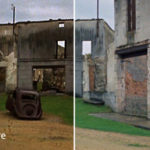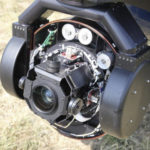
Kicking-Off: The Story of a Kick Ass Edit
Posted on Jul 19, 2010 by Alex Fice
Story by editors Eddie Hamilton and Jon Harris (not pictured)Kick-Ass, the low-budget epic, which follows the exploits of a hapless wannabe-superhero who just happens to be bereft of any actual super powers, has won accolades for its stunning visuals and stellar sound. As film editor Eddie Hamilton explains, the movie’s production relied heavily on an all-Avid workflow for picture and sound, including Media Composer Mojo DX and Nitris DX systems, Pro Tools, ICON, and Avid Unity MediaNetwork.
“I’ve been a Media Composer user since 1995, and Avid is really the only technology I’d trust for a full-length feature film,” says Hamilton, who worked closely with fellow editor Jon Harris on the project. “There’s no other system that allows all facets of the production to collaborate and share information the way Avid systems can.”
It’s obvious when talking to Hamilton that he’s as passionate about technology as he is about storytelling. “I love the technology,” he says. “My first love is editing a scene — after all, a film is written on the page and rewritten in the edits — but I also love working on intricate visual effects, or building a theatrical sound track.”
Harris, conversely, largely eschews the technical trappings. “I have one interest, and that’s the story,” he says. “I don’t edit in Media Composer, I edit in my head. But for me, Media Composer is the most fluid and intuitive method of getting from thought to fingers to screen. With Media Composer, I don’t even think about what I want to do, I just do it, and I see it in front of me.”
“We complement each other well,” says Hamilton. “There’s a lot of really complex, detail-oriented action sequences, and I don’t mind spending six weeks on those, whereas Jon would much rather be getting busy restructuring the first act of the movie. What’s great about Media Composer is that it can easily accommodate our different approaches to editing.”
 Kick Ass was an all AVID edit jobVideo editing was largely handled at London’s Elstree Studios. “I had my own [Media Composer] Mojo DX system in one suite, Jon was on a [Media Composer] Nitris DX [system] in a second suite, and we had two assistants on Nitris [systems] in a third,” says Hamilton. “We shared a Unity MediaNetwork system, which was just amazing. We all shared a single project, and we all could open it instantaneously. Jon was on a Mac, I was on a PC, and we had zero issues with compatibility.”
Kick Ass was an all AVID edit jobVideo editing was largely handled at London’s Elstree Studios. “I had my own [Media Composer] Mojo DX system in one suite, Jon was on a [Media Composer] Nitris DX [system] in a second suite, and we had two assistants on Nitris [systems] in a third,” says Hamilton. “We shared a Unity MediaNetwork system, which was just amazing. We all shared a single project, and we all could open it instantaneously. Jon was on a Mac, I was on a PC, and we had zero issues with compatibility.”
Hamilton points to Avid DNxHD encoding as instrumental in keeping file sizes manageable. “We were working at DNxHD 36, which I love because the file sizes are small but the quality’s incredible,” he says. “We only used about 5.5 TB of storage for the whole project.”
Those file sizes also enabled the project’s portability. “When we were in L.A., I could carry a consolidated version of the movie on a 250 GB mini-USB drive,” Hamilton says. “Quite often [director] Matthew [Vaughn] would want to change some music or tweak the edit a few hours before a screening, so we’d rent an Avid HD editing suite for an hour, plug in the drive, and make the change.”
Being able to quickly export QuickTime files from Media Composer also helped streamline the film’s screening process. “I’d export a compressed HD H.264 QuickTime file and carry it on a memory stick,” says Hamilton. “We’d use that for screenings rather than an HDCAM tape. I could take that to the biggest cinema in the world, or plug it into someone’s home theater system.”
Watching the film, it’s astounding to realise that many of the scenes are not what they seem. “The plot is set in Manhattan, but Matthew prefers to shoot in London,” Hamilton explains. “It’s not just a budgetary consideration, since filming gunfire and fight sequences in Manhattan can be a bit problematic. So we built a set at Elstree Studios with an enormous green screen. We got high-resolution plates of Manhattan and imported them into Media Composer. Media Composer’s got amazing motion tracking tools, so you can track the background using the on-set tracking markers. There’s a feature called SpectraMatte that allows you to adjust keys with such detail — it’s incredibly realistic.”
Audio was recorded with meticulous attention to detail. “Matthew is insistent on getting the highest-quality recordings of the original production sound, so the actors never have to try and re-create the emotion of the moment on a stage a month later,” says Hamilton.
“The original production audio was so clean at times that it made it even more important for us to achieve an interesting soundscape to cut through the film,” says Phaze UK’s Danny Sheehan who, along with partner Matthew Collinge, handled the film’s audio post production. With credits that include Snatch, Finding Neverland, and Stardust, Phaze UK’s facility includes four fiber-networked Pro Tools|HD workstations, as well as a mix stage outfitted with an ICON D-Command console.
“Simon Hayes, Matthew Vaughn’s audio recordist, would use a mixture of multiple radio and boom mics, and we’d often end up with eight or ten channels of audio to work with,” says Sheehan. “Eddie also does quite a bit of work on the audio right from day one. We’d get an OMF file from Eddie, along with his effects and an EDL — which we’d use to conform all of Simon’s original multitracks — and import that into Pro Tools. That allowed us to go back and work with some of the other tracks if we needed to save a bit of dialogue due to background noise. Thanks to Simon’s hard work and some tweaking within Pro Tools, we ended up only needing about four lines of ADR in the whole film.”
Sheehan handled Foley and dialogue, using a cocktail of noise-reduction plug-ins from Waves, iZotope, and Avid. Collinge worked on most of the sound design, using hardware synths and Native Instruments plug-ins. And the tight integration between the D-Command console, Pro Tools|HD, and Pro Tools plug-ins provided the perfect user interface.
“We’ve used Pro Tools since our very early days,” says Sheehan. “Integrating the D-Command into our studio allows us to manage and control much more of the project. It enables us to do so much more toward the final mix, giving the mixers more time to be creative.”
The film’s wide-ranging soundtrack was also a challenge, maintaining consistency with material ranging from Elvis to The Prodigy. “Matthew Vaughn really likes to use commercial music tracks to drive a sequence, and only feather in sound design where it’s needed,” says Sheehan. “The way the gunshot elements played against the music tracks during the big shoot-out scenes was a huge challenge to mix. Having the D-Command during the final mix, with all the effects running live within Pro Tools, gave us the flexibility to make instantaneous changes right on the mix stage.”
A big part of what makes Kick-Ass work is the quality of both the production and the story line. As Hamilton observes, much of that is due to Matthew Vaughn’s ability to maintain a firm grip on his vision. “Matthew is very passionate and very focused,” he says. “So many movies these days are made by committee. The fact that Matthew made Kick-Ass independently really makes it fresh and engaging. Every shot, every sound, every piece of music is exactly what he wants the audience to experience.”
“It’s a low-budget film, but it really doesn’t look like one,” agrees Sheehan. “So much care was taken in the filming and recording, and that quality makes a big difference.”
Vaughn’s hand-picked crew is another important aspect of the chemistry. “Matthew has a network of people he’s worked with before, and we all work well together,” says Sheehan. “I think the fact that all of us involved in the project—audio and video alike — understand the entire process really makes a difference. There’s a communication between audio and video people that doesn’t usually exist in other productions, and I think that comes across in Kick-Ass. It notches up everyone’s game. Instead of spending weeks cleaning up dialog, now we’ve got weeks to be creative.”
Harris agrees. “We all understand each other’s roles, and that makes a big difference. Nowadays I think it’s important for people to know a bit of everything, because everything’s so integrated. You don’t have to be the best at everything, but if you know a bit about the whole process, you can better prepare your own part to pass on.”
Harris offers this advice for aspiring film editors: “There’s no better education than just getting out there and doing it. These days, you can carry around in your backpack everything you need to completely make and edit a feature film. You can shoot a film on Saturday, edit it on Sunday, and have it on YouTube by Sunday night.”
“Each of us has a genuine passion for the art of telling a story,“ says Hamilton. “I love working on something that has the potential to give enjoyment to audiences all over the world. I’ve attended many screenings of Kick-Ass, and I love hearing the laughter and the cheering of the audience. That’s what I love about this job. It’s like an immensely rewarding jigsaw puzzle.









